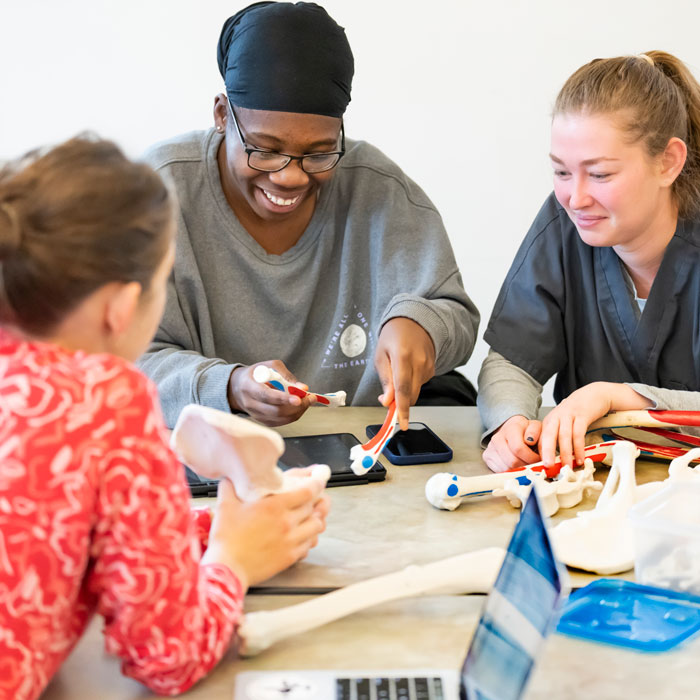Unlike anatomy students at many small liberal arts colleges, anatomy students at CC are provided with the opportunity to learn human anatomy from anatomical donors in the anatomy lab on campus.
“I really enjoyed learning from the donors in lab; it’s such an amazing opportunity CC students have,” says Molly Widlund ’25, who hopes to attend medical school to study neurosurgery after graduating.
“It is such a unique and special opportunity to learn from donors in an undergraduate setting. I could not pass the opportunity up, and I feel so lucky to have taken the course,” says Charlotte Agliata ’25.
“My favorite part of the course was being able to study in lab, because it's a very unique and special opportunity to study donors in an undergraduate, liberal arts setting. We learned nearly every bone in the body, and many of the muscles which originate and insert on those bones, as well as the actions of those muscles,” says Agliata.
While working in the anatomy lab was an incredible opportunity for students, the students in Block 4 HK204 Introduction to Human Anatomy class also believe that being able to take the class on the Block Plan gave them opportunities that they would not have gotten had they taken the class on a regular, semester-length schedule.
Ommay Khyr ’25 decided to take the class because she heard that the class uses anatomical donors, and as a pre-medical student, she really wanted to work with them.
“I love how the block allowed me to focus on anatomy alone. I also got more opportunities to be in the lab with the anatomical donors every day. I am a visual learner, and this class being on the block allowed me to see the donors every day,” says Khyr.
“The Block Plan is so immersive, so if I was taking this class on a semester schedule, I would not have spent as much time in the lab, and I would have been less focused on each topic,” says Widlund, who is a molecular biology major and history minor.
Agliata says this class was a perfect example of why she chose CC: because of its Block Plan.
“We were given class material a day in advance, so we could study that, and then the material would be covered in lecture before going into the lab to see the same muscles and bones on the donors that we had talked about in class. At a semester school, I doubt I would have had the ability to spend one to two hours a day in the lab studying the donors, which immensely benefitted my learning,” says Agliata, who also plans to apply to medical school after graduating.
“I definitely learned way more about the human body in three-and-a-half weeks than I ever could've imagined,” says Agliata.
Dan Miska, senior lecturer in the Human Biology and Kinesiology Department, has taught HK204 since he first started at CC in 2014. Miska says that teaching the class virtually during the COVID-19 pandemic was difficult, because so much of the class is lab-based. However, Miska arranged for the students to access a virtual lab program, which was so beneficial that the class still uses it today, despite also being able to work in the physical lab on campus.
The class followed a unique schedule. On Mondays through Wednesdays, the first half of the class was spent in the classroom, where students participated in group discussions and did pre-lab work, says Miska. The class would go over what they would be doing in the lab that day, as well as answer any lingering questions about previous work. After a short break, students would change into scrubs and meet at the anatomy lab, where they had the opportunity to learn from anatomical donors. In the lab sessions, students worked in small groups to locate the muscles, arteries, veins, and nerves that they had talked about in class.
“It was great to get such immediate hands-on experience with the donors after first learning the structures in class or for homework the night before,” says Agliata.
“The body and its movement fascinate me, and I took the anatomy course to see and understand the movements of the body,” says Khyr. Khyr spent about two hours each day prepping for class the next day.
Thursdays were used for open lab, where students had six hours to prepare and study for the lab exam, which took place on Fridays. Students could come and go as they pleased during open lab, which gave students flexibility, and allowed them to focus on whatever topic they needed additional time on.
Lab classes usually lasted about 90 minutes, but students had the opportunity to stay longer if they wanted to.
The class is almost always full and typically has a waitlist. There is a 16-person waitlist for Introduction to Human Anatomy in Block 5, says Miska. There were 20 students in the Block 4 class.



